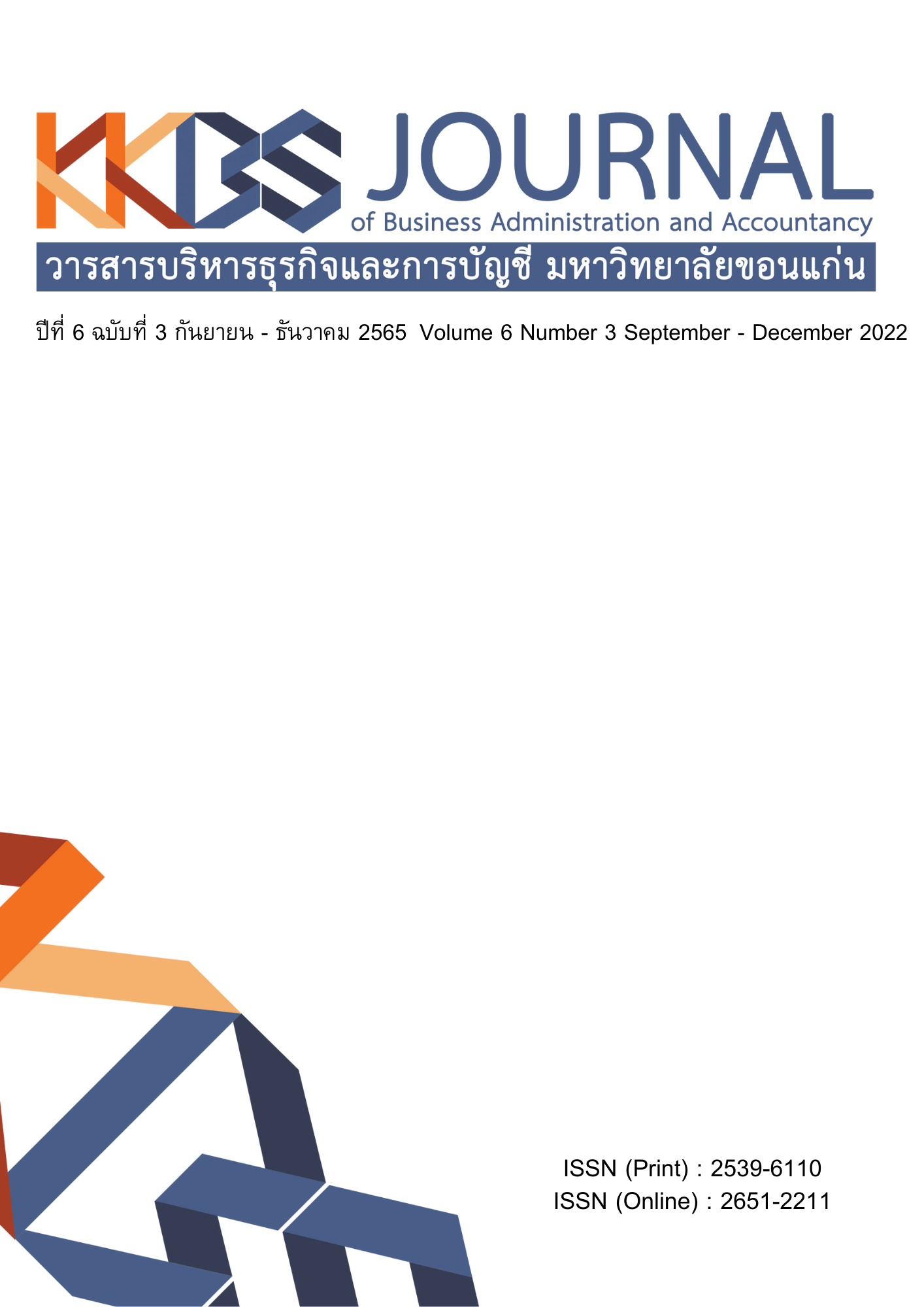Tendencies Toward the Application of Digital Technology for Administration in the Local Administrative Organizations: The case study of the municipalities in Khon Kaen Smart City Area
Main Article Content
Abstract
This research article aims to investigate the tendency and pattern of digital technology application for the administration of the five municipalities in a pilot area implementing the Khon Kaen Smart City phase 1. The study collected the primary data by interviewing the key informants categorized into three groups, including (1) local executive at policy level (2) officials at the operational level, and (3) private firm and technological entrepreneur. Additionally, related texts and information were analyzed by using documentary research along with thematic analysis as analytical techniques.
The results have found that the five municipalities have trended to apply the digital technology enhancing their LAOs’ administrative capabilities. Their main objectives are to increase the efficiency of internal administration and to improve the quality of life of the citizens as users of public services. The objectives have corresponded to policy directions of the central government, the rapid changes and disruption in socio-economic conditions and public values of the 21st-century society, and the emerging awareness in technology that empowers the living of different demographics in the aging society. In conclusion, the principal factor that encourages the municipalities to be more digitalized is that they trust the power of digital technology in providing a better internal administration’s performance of the LAOs. Namely, to be faster, convenient, economical, and efficient, which will significantly affect the development of quality public goods and services they are responsible for. However, it has emphasized that the Khon Kaen Municipality has the highest degree of digital technology application, considering a qualitative dimension of its administration. Khon Kaen Municipality has shown its digital technology application into a diverse aspect of its organizational management, having a broader scope and complexity of services. This digitalization of the local administration would have resulted from a pioneership and visionary leadership of an organization, budgetary and economic competitiveness, and multilateral collaborative network.
Article Details

This work is licensed under a Creative Commons Attribution-NonCommercial-NoDerivatives 4.0 International License.
The articles published in the journals are the authors' opinions, not the opinion of the editorial team or administrative staff. The articles published is copyright of the Journal of Business Administration and Accounting, Khon Kaen University.
References
Albino, V., Berardi, U. & Dangelico, R. (2015). Smart Cities: Definitions, dimensions, performance, and initiatives. Journal of Urban Technology, 22(1), 3-21.
Backus, M. (2001). E-Governance and developing countries. Ghana: IICD.
Buffel, T. & Phillipson, C. (2016). Can global cities be' age-friendly cities' ? Urban developement and aging populations. Cities, 55, 94-100.
Center for Governance. (2003). Smart capital evaluation guildlines report: Performance measurement and assessment for smart capital. Ottawa: University of Ottawa.
Centre for Cities. (2014). Smart cities definitions. Retrieved December 2019, 15, from https://www.centreforcities.org/reader/smart-cities/what-is-a-smart-city/1-smart-cities-definitions/
EEC Committee. (2020). Smart cities: Strategic sustainable development for an urban world. Retrieved December 21, 2019, from https://eeco.or.th/pr/news/ThaiGovExpandsSmartCityProjectEEC. (In Thai)
ETDA. (2020). E-governance gossaries. Retrieved December 21, 2019, from https://www.etda.or.th/terminology-detail/1018.html. (In Thai)
DEPA. (2020). DEPA: Goal and area. Retrieved December 21, 2019, from https://www.depa.or.th/th/digitalservice/smartcity/goals-and-areas.
Hussein, A. (2009). The use of triangulation in social sciences research: Can qualitative and quantitative methods be combined? Journal of Comparative Social Work, 1, 1-12.
Jareonsubphayanonta, N. & Narot, P.K. (2016). The e-government situation in Thai Local Government: Municipalities in Khon Kaen province. Journal of Mekong Societies, 12(1), 61-76. (In Thai)
Lawton, A. & Macaulay, M. (2014). Localism in practice: Investigating citizen participation and good governance in local government standards of conduct. Public Administration Review, 74(1), 75-83. (In Thai)
Linders, D., Zhou-Peng Liao, C. & Wang, C. (2018). Proactive e-governance: Flipping the service delivery model from pull to push in Taiwan. Government Information Quarterly, 35(4), 68-76.
Meijer, A. (2015). E-governance innovation: Barriers and strategies. Government Information Quarterly, 32(2), 198-206.
Nam, T. & Pardo, T. (2011). Conceptualizing smart city with dimensions of technology, people, and institutions. New York: College Park.
Nishishiba, M., Jones, M. & Kraner, M. (2014). Research methods and statistics for public and nonprofit administrators. California: Sage Publications.
Organisation of Economic Cooperation and Development [OECD]. (2015). Ageing in cities. Paris: OECD.
Pamuk, A. (2004). Digital divide. In R.W. Caves. Encyclopedia of the city. London: Routledge.
Parycek, P. (2003). Electronic democracy: Chances and risks for municipalities. In A. Prosser. E-democracy: Technolog, rights and politics. Vienna: OCG.
Plavia, S. & Sharma, S. (2007). E-government and e-governance: Definitions/domain framework and status around the world. Hyderabad, India: ICEG.
Plouffe, L. & Kalache, A. (2010). Towards global age-friendly cities: Determining urban features that promote active aging. Journal of Urban Health, 87, 733-739.
Roger, R. (2004). Digital government. In R.W. Caves. Encyclopedia of the city. London: Routledge.
Rogers, E.M. (2003). Diffusion of innovation. 5th ed. New York: The Free Press.
Shat, F. & Pimenidis, E. (2016). E-voting versus e-trust: A case study of e-democracy in Palestine. Ljubljana, Slovenia: Academic Conferences and Publishing International Limited.
Suriyanon, P. (2014). The information technology usage status in local administrative organization in a case study of Banped Municipality, Maung District, Khon Kaen Province. Mahasarakham: Mahasarakham University Conference Report.
The Secretariat of the House of Representatives. (2015). Public sector management: E-government. Bangkok: The Secretariat.
Thite, M. (2011). Smart Cities: Implications of urban planning for human resource development. Human Resource Developement International, 14(5), 623-631.
UK-BIS. (2013). Smart cities background paper. London: Department of Business, Innovation, and Skills.
UK-BIS. (2014). Smart cities framework-guide to establishing strategies for smart cities and communities. London: Publicly Available Specifications (PAS).
UNESCO. (2005). Defining e-governance. Retrieved from http://portal.unesco.org/ci/en/ev.php-URL_ID=4404&URL_DO=DO_TOPIC&URL_SECTION=201.html
VIA Smart City Solutions. (2019). Smart city development and the needs of the elderly. Retrieved December 21, 2019, from https://www.viatech.com/en/2019/12/smart-cities-and-the-elderly/
Walker, J.L. (1969). The diffusion of innovations among the American States. American Political Science Review, 63, 880-899.


